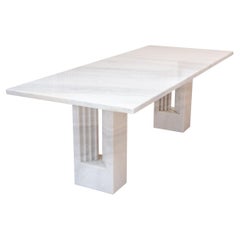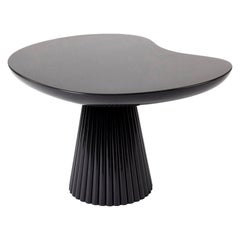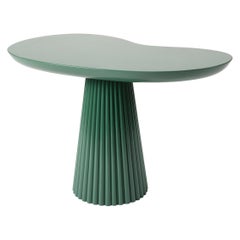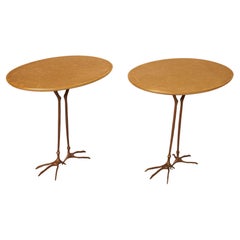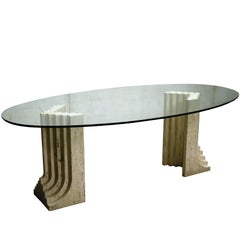Studio Simon Tables
10
to
8
1
10
10
10
9
10
2
7
1
7
Height
to
Width
to
Depth
to
5
4
3
2
2
10
10
9
795
766
456
398
Creator: Studio Simon
Studio Simon for Simon Gavina Italian Glass "Davide" Model Dining Table 1970s
By Simon Gavina Editions, Studio Simon
Located in Reggio Emilia, IT
Italian midcentury nodern design dining table “Davide “ model designed by Studio Simon and produced by Simon Gavina with partially foldable chrome-plated steel frame and clear glass ...
Category
1970s Italian Mid-Century Modern Vintage Studio Simon Tables
Materials
Metal
Black Folding Table by Kazuhide Takahama
By Kazuhide Takahama, Studio Simon
Located in Dronten, NL
Rare early black lacquered square table by Kazuhide Takahama for Simon International that folds out to a rectangular table when desired. Magnifi...
Category
1970s Italian Mid-Century Modern Vintage Studio Simon Tables
Materials
Plywood
Constantin wood side table by Gavina, Homage to Brancusi, 1971 (First Edition)
By Gavina, Studio Simon
Located in Argelato, BO
Constantin Side Table, Homage to Brancusi by Gavina, Italy, 1971. (First Edition)
The Constantin designer coffee table is a work of art included in the Ultramobile collection design...
Category
1970s Italian Mid-Century Modern Vintage Studio Simon Tables
Materials
Brass
Carlo Scarpa & Marcel Breuer Naxos Marble “Delfi” Table for Studio Simon, 1969
By Carlo Scarpa, Marcel Breuer, Studio Simon
Located in Vicenza, IT
“Delfi” dining table, designed by Carlo Scarpa and Marcel Breuer and produced by the Italian manufacturer Studio Simon in 1969.
Made of white Nax...
Category
1960s Italian Mid-Century Modern Vintage Studio Simon Tables
Materials
Marble
Davide Table by Studio Simon, 1970
By Studio Simon
Located in Ozzano Dell'emilia, IT
Davide table designed by Studio Simon and produced by Simon.
Partially foldable chromed steel structure, transparent glass top.
Bibliography:
Fondazione Scientifica Querini Stampal...
Category
1970s Italian Mid-Century Modern Vintage Studio Simon Tables
Materials
Steel
Studio Simon Granite Brutalist Samo Table in the Style of Carlo Scarpa, 1970
By Carlo Scarpa, Studio Simon
Located in Vicenza, IT
Dining table mod. ‘Samo’ by Studio Simon. Series ‘Ultrarazionale’. Italy, 1970.
Made of granite.
Literature: Giuliana Gramigna, Repertorio 1950-2000, Allemandi, Torino, 2003, p.180.
Excellent vintage condition.
The Samo table was designed in 1970 by the project office of Studio Simon. Carlo Scarpa was the brand's artistic director, and the Venetian architect's style inspired the shapes of this table.
Born in Venice on June 2nd, 1906, Carlo Scarpa began working at a very early age. Only a year after he had first qualified as an architect in 1926, he began working for the Murano glassmakers Cappellin & Co. in a consultative capacity; from 1927, he began to experiment with the Murano glass, and this research not only gave him excellent results here but would also inform his progress for many years to come. Between 1935 and 1937, as he entered his thirties, Carlo Scarpa accepted his first important commission, the renovation of Venice’s Cà Foscari. He adapted the spaces of this stately University building which stands on the banks of the Grand Canal, creating rooms for the Dean’s offices and a new hall for academic ceremonies; Mario Sironi and Mario De Luigi were charged with doing the restoration work on the frescos. After 1945, Carlo Scarpa found himself constantly busy with new commissions, including various furnishings and designs for the renovation of Venice’s Hotel Bauer and designing a tall building in Padua and a residential area in Feltre, which are all worth mention. One of his key works, despite its relatively modest diminished proportions, was the first of many works which were to follow in the nineteen fifties: the [bookshop known as the] Padiglione del Libro, which stands in Venice’s Giardini di Castello and shows clearly Scarpa’s passion for the works of Frank Lloyd Wright. In the years which were to follow, after he had met the American architect, Scarpa repeated similar experiments on other occasions, as can be seen, in particular, in the sketches he drew up in 1953 for villa Zoppas in Conegliano, which show some of his most promising work. However, this work unfortunately never came to fruition. Carlo Scarpa later created three museum layouts to prove pivotal in terms of how 20th century museums were to be set up from then on. Between 1955 and 1957, he completed extension work on Treviso’s Gipsoteca Canoviana [the museum that houses Canova’s sculptures] in Possagno, taking a similar experimental approach to the one he used for the Venezuelan Pavilion at [Venice’s] Giardini di Castello which he was building at the same time (1954-56). In Possagno Carlo Scarpa was to create one of his greatest ever works, which inevitably bears comparison with two other museum layouts that he was working on over the same period, those of the Galleria Nazionale di Sicilia, housed in the Palazzo Abatellis in Palermo (1953-55) and at the Castelvecchio in Verona (1957- 1974), all of which were highly acclaimed, adding to his growing fame. Two other buildings, which are beautifully arranged in spatial terms, can be added to this long list of key works that were started and, in some cases, even completed during the nineteen fifties. After winning the Olivetti award for architecture in 1956, Scarpa began work in Venice’s Piazza San Marco on an area destined to house products made by the Industrial manufacturers Ivrea. Over the same period (1959-1963), he also worked on renovation and restoration of the gardens and ground floor of the Fondazione Querini Stampalia in Venice, which many consider being one of his greatest works. While he busied himself working on-site at the Fondazione Querini Stampalia, Carlo Scarpa also began work building a villa in Udine for the Veritti family. To shed some light on the extent to which his work evolved over the years, it may perhaps be useful to compare this work with that of his very last building, villa Ottolenghi Bardolino, which was near to completion at the time of his sudden death in 1978. Upon completion of villa Veritti over the next ten years, without ever letting up on his work on renovation and layouts, Scarpa accepted some highly challenging commissions which were to make the most of his formal skills, working on the Carlo Felice Theatre in Genoa as well as another theatre in Vicenza.
Towards the end of this decade, in 1969, Rina Brion commissioned Carlo Scarpa to build the Brion Mausoleum in San Vito d’Altivole (Treviso), a piece he continued to work on right up until the moment of his death. Nevertheless, even though he was totally absorbed by work on this mausoleum, there are plenty of other episodes which can offer some insight into the final years of his career. As work on the San Vito d’Altivole Mausoleum began to lessen from 1973, Carlo Scarpa began work building the new headquarters for the Banca Popolare di Verona. He drew up plans that were surprisingly different from the work he was carrying out at the same time on the villa Ottolenghi. However, the plans Carlo Scarpa drew up, at different times, for a monument in Brescia’s Piazza della Loggia commemorating victims of the terrorist attack on May 28th, 1974, make a sharp contrast to the work he carried out in Verona, almost as if there is a certain hesitation after so many mannered excesses. The same Pietas that informs his designs for the Piazza Della Loggia can also be seen in the presence of the water that flows through the Brion Mausoleum, almost as if to give a concrete manifestation of pity in this 20th century work of art. Carlo Scarpa has put together a highly sophisticated collection of structures, occupying the mausoleum’s L-shaped space stretching across both sides of the old San Vito d’Altivole cemetery. A myriad of different forms and an equally large number of different pieces, all of which are separate and yet inextricably linked to form a chain that seems to offer no promise of continuity, rising up out of these are those whose only justification for being there is to bear the warning “si vis vitam, para mortem”, [if you wish to experience life prepare for death] as if to tell a tale that suggests the circle of time, joining together the commemoration of the dead with a celebration of life. At the entrance of the Brion Mausoleum stand the “propylaea” followed by a cloister which ends by a small chapel, with an arcosolium bearing the family sarcophagi, the main pavilion, held in place on broken cast iron supports, stands over a mirror-shaped stretch of water and occupies one end of the family’s burial space. The musical sound of the walkways teamed with the luminosity of these harmoniously blended spaces shows how, in keeping with his strong sense of vision, Carlo Scarpa could make the most of all of his many skills to come up with this truly magnificent space. As well as a great commitment to architectural work, with the many projects which we have already seen punctuating his career, Carlo Scarpa also made many equally important forays into the world of applied arts. Between 1926 and 1931, he worked for the Murano glassmakers Cappellin, later taking what he had learned with him when he went to work for the glassmakers Venini from 1933 until the 1950s. The story of how he came to work on furniture design is different, however, and began with the furniture he designed to replace lost furnishings during his renovation of Cà Foscari. The later mass-produced furniture started differently, given that many pieces were originally one-off designs “made to measure”. Industrial manufacturing using these designs as prototypes came into being thanks to the continuity afforded him by Dino Gavina, who, as well as this, also invited Carlo Scarpa to become president of the company Gavina SpA, later to become SIMON, a company Gavina founded 8 years on, in partnership with Maria Simoncini (whose own name accounts for the choice of company name). Carlo Scarpa and Gavina forged a strong bond in 1968 as they began to put various models of his into production for Simon, such as the “Doge” table, which also formed the basis for the “Sarpi” and “Florian” tables. In the early seventies, other tables that followed included “Valmarana”, “Quatour” and “Orseolo”. While in 1974, they added couch and armchair “Cornaro” to the collection and the “Toledo” bed...
Category
1970s Italian Mid-Century Modern Vintage Studio Simon Tables
Materials
Granite
Studio Simon, Constantin Occasional Table With Brass Top
By Studio Simon, Cassina
Located in Ferndale, MI
Studio Simon Constantin occasional table in oak wood with a polished brass top. The brass top appears to be floating on the thickset wood base. Italy, 1971 / 2013
Base measures 10.75...
Category
1970s Italian Post-Modern Vintage Studio Simon Tables
Materials
Brass
Table ’Traccia’ by Meret Oppenheim for Simon Gavina, Italy, 1972
By Meret Oppenheim, Studio Simon
Located in Echt, NL
Original ’Traccia’ table in very good condition.
Designed by Meret Oppenheim
Produced by Studio Simon’s Collezione Ultramobili, Milan, 1972
The tabletop is covered in gold leaf and has bird tracks embossed in the surface.
The top rests on two brass feet in the form of bird legs.
The original table was exhibited by the Surrealist artist Meret Oppenheim in 1939 for the Parisian gallery René Drouin...
Category
20th Century Italian Mid-Century Modern Studio Simon Tables
Materials
Brass, Gold Leaf
Table "Bisanzio" des. Carlo Scarpa and Hiroyuki Toyoda for Simon 1973
By Studio Simon
Located in Melbourne, VIC
Elegant Dining table designed by Carlo Scarpa and produced by Simon. Following the death of Scarpa, the design was refined and finished by Hiroyuki Toyoda in conjunction with Dino ...
Category
Mid-20th Century Italian Mid-Century Modern Studio Simon Tables
Ming Coffee Table by Kazuhide Takahama, 1970s
By Kazuhide Takahama, Studio Simon
Located in HEVERLEE, BE
Black lacquered coffee table model 'Ming' designed by Kazuhide Takahama and produced by Studio Simon.
This very large coffee table is very simply designed yet looks beautiful.
...
Category
1970s Italian Mid-Century Modern Vintage Studio Simon Tables
Materials
Lacquer
Related Items
Homage to Miro Table by Thomas Dariel
Located in Geneve, CH
Homage to Miro table by Thomas Dariel, Maison Dada
Different available dimensions :
Side table n°1 • L 85 * D 49 x H 53cm
Side table n°2 • L 87 x D 55 x H 40cm
Side table n°3 • L...
Category
2010s French Modern Studio Simon Tables
Materials
Wood
Homage to Miro Table by Thomas Dariel
Located in Geneve, CH
Homage to Miro table by Thomas Dariel, Maison Dada
Different available dimensions:
Side table n°1 • L85*D49*H53cm
Side table n°2 • L87*D55*H40cm
Side table n°3 • L68*D56*H40cm
T...
Category
2010s French Modern Studio Simon Tables
Materials
Wood
Mid-Century Mod Delfi White Marble Dining Table by Carlo Scarpa & Marcel Breuer
By Marcel Breuer, Carlo Scarpa
Located in Madrid, ES
Dining table mod. Delfi designed by Carlo Scarpa and Marcel Breuer for Gavina. Composed of two sculptural bases and a rectangular top 4 cm thick. Made in Carrara marble. Italy 1968. ...
Category
1960s Italian Mid-Century Modern Vintage Studio Simon Tables
Materials
Carrara Marble
H 29.34 in W 86.62 in D 35.44 in
Mid-Century Modern Carlo Scarpa Cream Travertine Dining Table "Argo", 1970
By Carlo Scarpa
Located in Le Grand-Saconnex, CH
Mid-Century Modern oval travertine dining room table, model Argo.
Designed in 1970 by Carlo Scarpa (1906-1978) for the "Ultrarazionale" collection, produced and sold by Cattelan Ital...
Category
1970s Italian Mid-Century Modern Vintage Studio Simon Tables
Materials
Travertine
H 28.35 in W 78.75 in D 47.25 in
Carlo Scarpa "Samo" Oval Table for Simon Gavina, 1971
By Carlo Scarpa, Simon Gavina Editions
Located in Lonigo, Veneto
Carlo Scarpa "Samo" oval table for Simon Gavina, white Carrara marble, Italy, 1971.
The Scarpa's way of thinking the architecture is particularly visible in this piece. The “Samo” d...
Category
1970s Italian Mid-Century Modern Vintage Studio Simon Tables
Materials
Carrara Marble
Antella Table by Kazuhide Takahama for Simon Gavina
By Gavina, Kazuhide Takahama
Located in Brooklyn, NY
This black laquered table by Kazuhide Takahama can be used as a dining table or folded down to a demi lune shaped console table.
Category
1980s Italian Mid-Century Modern Vintage Studio Simon Tables
Materials
Wood
Carlo Scarpa 'Samo' Dining Table for Simon Gavina, Italy, 1970s
By Carlo Scarpa, Simon Gavina Editions
Located in Hellouw, NL
This Italian dining table from the 1970s exudes timeless elegance and beauty. It was designed by perhaps one of the prominent Italian modernist designers of the last century. What im...
Category
1970s Italian Mid-Century Modern Vintage Studio Simon Tables
Materials
Granite
1970s Norman Foster Glass Table Model Nomos for Tecno, Italy
By Sir Norman Foster
Located in Praha, CZ
- good /very good condition with minor signs of use.
Category
1970s Italian Mid-Century Modern Vintage Studio Simon Tables
Materials
Metal
Large Travertine Pedestal "Argo" Dining Table by Carlo Scarpa for Simon/Gavina
By Carlo Scarpa, Simon Gavina Editions
Located in Danville, CA
This is the largest, single-pedestal version of this iconic design by Carlo Scarpa for Simon c. 1975. This most desirable piece is constructed of solid, beautifully figured Cream col...
Category
1970s Italian Mid-Century Modern Vintage Studio Simon Tables
Materials
Travertine
H 29 in W 78.5 in D 47 in
Carlo Scarpa 'Samo' table for Simon in white marble, 1970s
By Carlo Scarpa
Located in Milano, IT
Iconic dining table with oval top model 'Samo' designed by Carlo Scarpa in 1970 and produced by Simon; in white saccaroid marble.
Category
1970s Italian Mid-Century Modern Vintage Studio Simon Tables
Materials
Marble
Early Carlo Scarpa Quatour Table for Simon Gavina, Italy, 1974
By Simon Gavina Editions, Carlo Scarpa
Located in Milan, IT
Early and Large version Carlo Scarpa Quatour table for the Metamobile series by Simon Gavina, Italy 1974.
Category
1970s Italian Mid-Century Modern Vintage Studio Simon Tables
Materials
Wood, Pine
Samo Table in white marble, Carlo Scarpa
By Carlo Scarpa
Located in Milano, Lombardia
Carlo Scarpa's Samo Table is made of white marble. The legs are seated by a single block with grooves and thick oval top. If you belong to the ‘Ultrarational’ series, this item is on...
Category
1960s Italian Modern Vintage Studio Simon Tables
Materials
Carrara Marble
Previously Available Items
Pair of Meret Openheim 'Traccia' tables, c1970
By Meret Oppenheim, Studio Simon
Located in London, GB
A pair of restored Meret Openheim 'Traccia' tables for Studio Simon.
A superb pair of Surrealist tables designed by Meret Openheim in the 1930s. Fully restored.
Category
1970s Italian Mid-Century Modern Vintage Studio Simon Tables
Materials
Bronze
Vintage Travertine Oval Dining Table by Studio Simon Italy, 1980s
By Studio Simon
Located in HEVERLEE, BE
Exquisite travertine 'Samo' dining table by studio Simon
This 'Samo' model table is part of the 'Ultrarazionale' collection by Simon where it is showcased with use of marble base ...
Category
1980s Italian Mid-Century Modern Vintage Studio Simon Tables
Materials
Travertine
1978 'Antella' Table or Console by Kazuhide Takahama, Simon International, Italy
By Kazuhide Takahama, Studio Simon
Located in Girona, ES
"Antella" foldable table or console, frame and top with rounded front edge, two hinged elements held together by a magnet, two halves of elliptical tabletop panels, black lacquered.
...
Category
1970s Italian Mid-Century Modern Vintage Studio Simon Tables
Materials
Wood
H 28.35 in W 66.54 in D 47.25 in
Studio Simon tables for sale on 1stDibs.
Studio Simon tables are available for sale on 1stDibs. These distinctive items are frequently made of wood and are designed with extraordinary care. There are many options to choose from in our collection of Studio Simon tables, although brown editions of this piece are particularly popular. Many of the original tables by Studio Simon were created in the mid-century modern style in italy during the 20th century. If you’re looking for additional options, many customers also consider tables by Sandro Petti, RIMA, and Luigi Saccardo. Prices for Studio Simon tables can differ depending upon size, time period and other attributes — on 1stDibs, these items begin at $2,057 and can go as high as $17,800, while a piece like these, on average, fetch $4,650.

